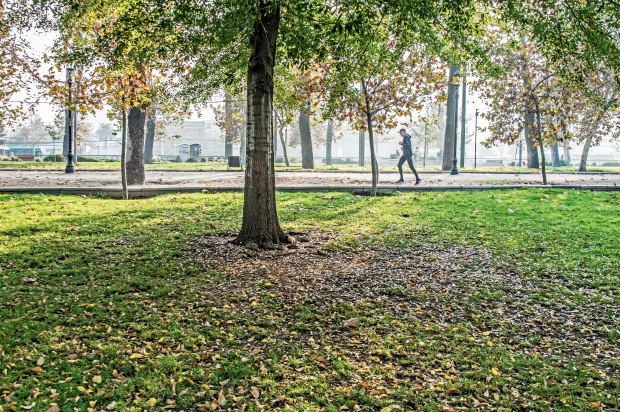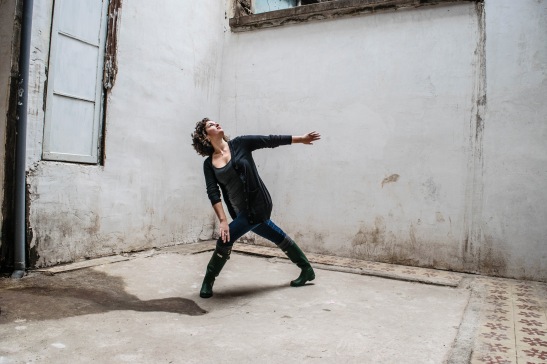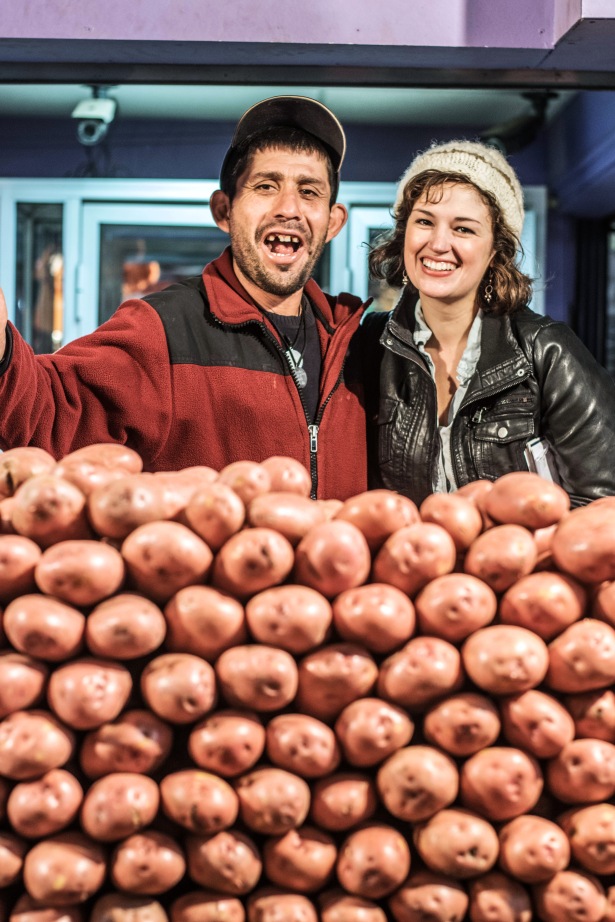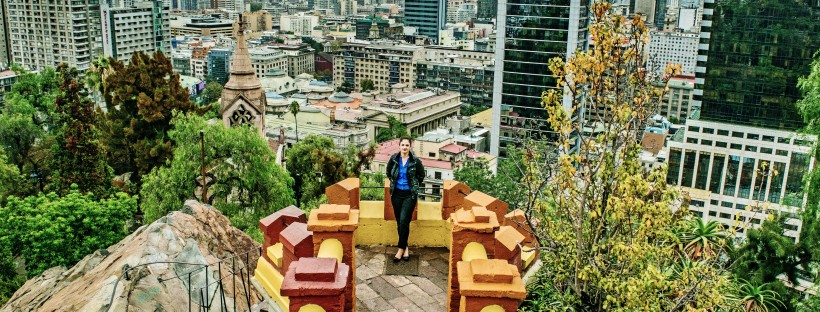Welcome to Santiago, dear readers. I’ve been quiet for a bit, and I wish I hadn’t been because life happens fast. Discoveries every step of the way keep me playing along and optimistic that soon, normalcy will creep in. Tuesday, May 31st marks five months of living in Chile.

At the start of May the Llama and I moved from Viña del Mar on the coast to Santiago, the capital city in the central valley. Here, coastal breezes aren’t so brisk, work is more plentiful, and most importantly, it pays better. We’ve been running from end to end of Santiago, often on foot which is our favorite way, learning about our surroundings and looking for a place to live.
Our introduction to Santiago back in January wasn’t the most encouraging. Instead of refreshed and well-researched, we arrived disoriented and exhausted from moving and wedding planning and getting married and then jumping on a plane with everything we own (which is not to say we would have done it any other way…). The city felt hot, artificial and stale, closed up and empty. It had everything to do with the holiday—Santiaguinos don’t stay in the city over New Year’s Weekend if it can be helped.

But having lived here for a month we now know what so many others do: that Santiago is not only developed and prosperous, but colorful and imaginative. Valparaíso gets more credit for its cultural vibrancy, perhaps because that is its main draw. But Santiago has as much artistic flavor as Valparaiso, and more—as well as infrastructure and moneyed consumers to support the community, because really, artists can only starve for so long.

I fall in love with Santiago every day. On weekends we discover new places as we run errands and check out possible apartments. And the more we explore, the more I understand and relate with my surroundings. We are learning where to go when we need leafy green parks and fresh fall air, and where to find inspiration down historic city blocks with warm light and decorative tilework.

Santiago has the wild ability to surprise and delight me. Stumbling upon the Santiago Symphony in the Plaza de Armas at sunset cheered me on a night when I failed to find what I had gone out looking for. A significant crowd gathered round to stop and pay attention, smiling and lingering in the low light.
Out for an evening paseo last night, the Llama and I clutched hands when we heard young voices in a nearby dark park. But we were delighted to find ourselves in the middle of a hip hop dance club, where small groups of youths were listening to music, often off of a cell phone, watching videos and copying choreography, teaching one another.
And this weekend, the first outing with the Santiago Foto Club lead us peeking down private roads and poking our noses (or cameras, as it were) into ignored places including a dilapidated house. There we met collaborators preparing for an electronic music concert in the central patio of the house. As they brought in their equipment, they didn’t mind the photographers wandering from room to empty room, adjusting for light and taking in the storied detail of the abandoned old home.

But the most heartwarming of all has been the people we have come in contact with in Santiago. Chileanos call everyone with (sometimes sarcastic) terms of endearment like flaca, joven, and my favorite, mi reina. Faces are often disengaged or inwardly focused until addressed directly with a question or a consulta. Then sunlight comes streaming through. Like the potato casero who insisted I come stand with him for a picture. Or the strawberry casero slinging jokes in a booming bass voice as we pass by in search of bananas.
“Where are you from?” He called out to us.
“The United States,” I called back. And just like that we’d drawn a curious crowd.
“My English is not very good,” he told me.
“Your English is great,” I encouraged him.
“I love the history of your country,” he continued, and went on to quiz me on the achievements of American presidents, trivia I had never heard before, or perhaps didn’t understand in his noble struggle with English.

Another Chileno pulled the Llama aside to chat when he heard us tell the strawberry man that he is from California.
“My son is living in Berkley. I need to learn English so that I can speak when I visit in a few months,” he said. It wasn’t long before the Llama had his number as a new student, and we carried away a kilo of strawberries.
This is our new life, today’s normal. Since we left our sweet rental house in Ashland last November, the Llama and I have stayed light on our feet to feel at home wherever we are together. The balance is precarious. I can’t deny that I look at the Llama every so often and ask him if this is it, if he thinks we should be giving up and going home now.
But I mean it less than before, and maybe I’ll stop asking at some point. I’m proud of what we’ve learned so far, and excited that there is so much more to come. We are cracking open our potential in a way that we couldn’t accomplish anywhere else in the world. And Santiago will always have a bit of my heart for that.

GLOSSARY
Santiaguino: Someone from Santiago.
Paseo: One of my favorite aspects of Spanish and Latino culture, which translates poorly to “going for a walk.” Paseo has the feeling of a promenade, of walking with the intention to observe and relax.
Flaco or flaca: Skinny or thin. As a term of endearment, flaco/a is used just as often for the not-so-skinny, or not-skinny-at-all.
Joven: Young as an adjective, or youth as a noun. As with flaco, not necessarily related to actual age of the person to whom it is directed.
Mi reina: My queen. I can’t help but smile when someone calls me this. I’m a sucker!
Casero: There is no direct translation for this word. It can be exchanged with “vendor,” but more closely suggests a relationship with home. Used as an adjective, casero can mean “homemade” or “homespun.” In Chile, there is a special relationship between seller and buyer in ferias, the open markets. In the exchange of buying and selling, there is an unwritten contract that the seller provides the best products to his or her loyal customers. In exchange, the customer does not go to another vendor simply for a lower price. The vendor offers not only the product purchased, but suggestions about proper handling and storage, and ideas or recipes for use. As a gringa, I have work to do in establishing myself with caseros, figuring out who I want to return to. I hope this will come naturally once we settle into a neighborhood and become familiar faces at the market. For now, I go to who appears to have the best product, and who makes me laugh.
Consulta: This is another Chileanismo that I find interesting. Instead of approaching someone and asking a pregunta, or question, Chileans propose una consulta. If an attendant in a store wants to know if they can help you find something, etc, they ask if they can offer una consulta.
Kilo: Kilogram, or 2.2lbs. At the ferias, the caseros sell in bulk, by the kilo. So most weekends the Llama and I spend about 10,000 CLP (or $14.50 USD) and carry home roughly 15 pounds of fresh produce, spices, cheese and eggs. In contrast, I could go to the grocery store and spend 20,000 (or $30.00 USD) for three items. It’s all about planning.

So great to read! Looks and sounds like it’s starting to feel more like a home 💕😀 your perspective is so beautiful…keep on inspiring! Saludos y abrazos del sur! 😘
LikeLike
Gracias Laura! We’re moving to our new home TODAY. It’s a crazy day, but we can’t wait to be sleeping in our own space tonight. Even if it is in sleeping bags on camping pads…:)
LikeLike
We spent several weeks in Chile recently and loved the Chilenos. We made some fabulous friends and we keep in touch now we are back in Oz. Looking forward to hearing some more adventures.
LikeLike
Thank you Helen! I’m excited to check out your post about bird life you observed in the Lakes District! One of my favorite things about living in the Southern Hemisphere is learning about the amazing new (to me!) flora and fauna. Thanks for saying “hola!”
LikeLike
I love the pictures and descriptions of your experience in Santiago. You’re very talented! Thank you for sharing! ♡
LikeLike
Thank you Evelyn! I appreciate you stopping by and saying so!
LikeLike
I loved this. I’ve been living in Santiago for about 4 months now, while on University exchange (originally from Sydney), and I completely agree with your post. I was happily surprised by the amount of street art in Santiago. It’s quite amazing. 🙂
LikeLike
Thank you for saying so, Catherine! Despite where we come from, when it comes right down to it, I think many of us agree more often than disagree. Cheers!
LikeLike